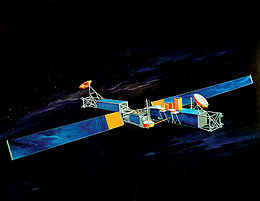Milstar
This article has multiple issues.Please helpimprove itor discuss these issues on thetalk page.(Learn how and when to remove these template messages)
|
 Artist's impression of a Milstar Block I spacecraft | |
| Manufacturer | Lockheed Martin(prime, formerly Lockheed Missiles and Space) Northrop Grumman(formerlyTRW) Boeing(formerlyHughes) |
|---|---|
| Country of origin | United States |
| Operator | U.S. Space Force |
| Applications | Military communications |
| Specifications | |
| Bus | Milstar Block I Milstar Block II |
| Launch mass | 4,500 kilograms (9,900 lb) |
| Regime | Geosynchronous |
| Design life | 10 years |
| Production | |
| Status | Out of production Active |
| Built | 6 |
| Launched | 6 |
| Operational | 5[citation needed] |
| Lost | 1 |
| Maiden launch | USA-99,1994-02-07 |
| Last launch | USA-169,2003-04-08 |
Milstar(Military Strategic and Tactical Relay)[1]is aconstellationofmilitarycommunications satellitesingeosynchronous orbit,which are operated by theUnited States Space Force,and provide secure and jam-resistant worldwide communications to meet the requirements of theArmed Forces of the United States.Six spacecraft were launched between 1994 and 2003, of which only five were operational after launch; the third launch failed, both damaging the satellite and leaving it in an unusable orbit.
History
[edit]Milstar Block I spacecraft, or Milstar Developmental Flight Satellite (DFS)-1 and -2, were designed with a Low Data Rate (LDR) payload in the+Xwing of the satellite that broadcast in theSuper High Frequency(SHF) andExtremely High Frequency(EHF) ranges, and also a classified communication payload in the-Xwing. The DFS-1 satellite was launched on 7 February 1994 aboard the firstTitan IV(401)Arocket, but with the classified-Xwing payload deactivated. It was followed by the DFS-2 spacecraft on 7 November 1995. DFS-2 was similar to DFS-1, but the classified payload was replaced byballastin the form of a precision machinedaluminumblock to maintain the weight and balance characteristics of the satellite. Both Block I satellites (USA-99 and USA-115) are still operational as of August 2016, over 20 years since they were launched.
The four later satellites were Block II spacecraft, which featured an additional medium data-rate payload. The first Block II satellite (DFS-3m, a hybrid mix of largely Block I support systems and LDR payload and a MDR (Medium Data Rate) Block II payload) was launched on 30 April 1999, using aTitan IV(401)Brocket. Due to a database error affecting the attitude control system of theCentaurupper stage of its carrier rocket, it was placed into a lower orbit than had been planned, and damaged by deployment at excessive rates. It could not be raised into its operational orbit due to fuel limitations. Its orbit was raised as much as possible to increase the expected lifetime and then it was permanently turned off after 10 days.[2][3]It was the third consecutive, and last, failure of a Titan IV rocket. The remaining three satellites (DFS-4, -5, and -6) were launched on 27 February 2001, 15 January 2002, and 8 April 2003.
The Milstar system consists of three segments; the space segment which consists of the six satellites, ground terminals and users, and stations to command and control the satellites. TheMilitary Satellite Communications Systems Wing(MCSW) division of theSpace and Missile Systems Center,located atLos Angeles AFBwas responsible for development and acquisition of the Milstar space and mission control segments. TheElectronic Systems CenteratHanscom AFBis responsible for the US Air Force portion of the terminal segment development and acquisition. The4th Space Operations SquadronatSchriever SFBand the148th Space Operations SquadronatVandenberg SFBare responsible for providing real-time satellite control and communications payload management.
In August 2010 control of the Milstar system was transferred to theAdvanced Extremely High Frequencyprogram, in preparation for the launch of the first AEHF satellite,USA-214.Advanced Extremely High Frequency satellites are intended to replace Milstar.[citation needed]
Characteristics
[edit]Milstar satellites provide secure, jam resistant, worldwide communications to meet the requirements of the United States military. They were built byLockheed Martin Missiles and Space Corporation,at a cost ofUS$800 million each. Each satellite has a design life of 10 years. Six were built, of which five reached their operationalgeosynchronous orbits,and remain in service. Launches were made usingTitan IVrockets with Centaur upper stages, and all six occurred fromSpace Launch Complex 40at theCape Canaveral Air Force Station.The satellites are designed to provide communications which are hard to detect and intercept, and to be survivable in the event ofnuclear warfare.
The spacecraft have a mass of 4,500 kilograms (9,900 lb), and are equipped withsolar panelswhich generate eightkilowattsofelectric powerto power itstransponders.Both Block I and Block II satellites provide low data-rate communications at bandwidths between 75 bit/s and 2,400 bit/s, whilst the Block II spacecraft can also provide medium data-rate communications between 4.8 kbit/s and 1.544 Mbit/s. The satellites' uplinks operate in theQ band,while their downlinks operate within theK band.The uplink corresponds to theextremely high frequencyband while downlink corresponds to thesuper high frequencyradio band.[citation needed]
Spacecraft
[edit]| USA ID | Name | Block | Launch date/time (UTC) | COSPAR ID | Rocket | Remarks |
|---|---|---|---|---|---|---|
| USA-99 | DFS-1 | Block I | 1994-02-07, 21:47:01 | 1994-009A | Titan IV(401)A | |
| USA-115 | DFS-2 | Block I | 1995-11-06, 05:15:01 | 1995-060A | Titan IV(401)A | |
| USA-143 | DFS-3M | Block I/II hybrid | 1999-04-30, 16:30:00 | 1999-023A | Titan IV(401)B | Launch failure |
| USA-157 | DFS-4 | Block II | 2001-02-27, 21:20 | 2001-009A | Titan IV(401)B | |
| USA-164 | DFS-5 | Block II | 2002-01-16, 00:30:00 | 2002-001A | Titan IV(401)B | |
| USA-169 | DFS-6 | Block II | 2003-04-08, 13:43:00 | 2003-012A | Titan IV(401)B |
See also
[edit]- Advanced Extremely High Frequency
- Defense Satellite Communications System
- Transformational Satellite Communications System
- Wideband Global SATCOM system
References
[edit]- ^"MILITARY STRATEGIC AND TACTICAL RELAY (MILSTAR) SATELLITE SYSTEM - FY00 Activity".
- ^"NASA - NSSDCA - Spacecraft - Details".nssdc.gsfc.nasa.gov.Retrieved2023-03-23.
- ^"Milstar-2 1, 2, 3, 4 (Milstar 3, 4, 5, 6)".Gunter's Space Page.Retrieved2023-03-23.
- King, Mak and Riccio, Michael J. (Spring 2010). "Military Satellite Communications: Then and Now".Crosslinks Magazine.Aerospace Corp.

